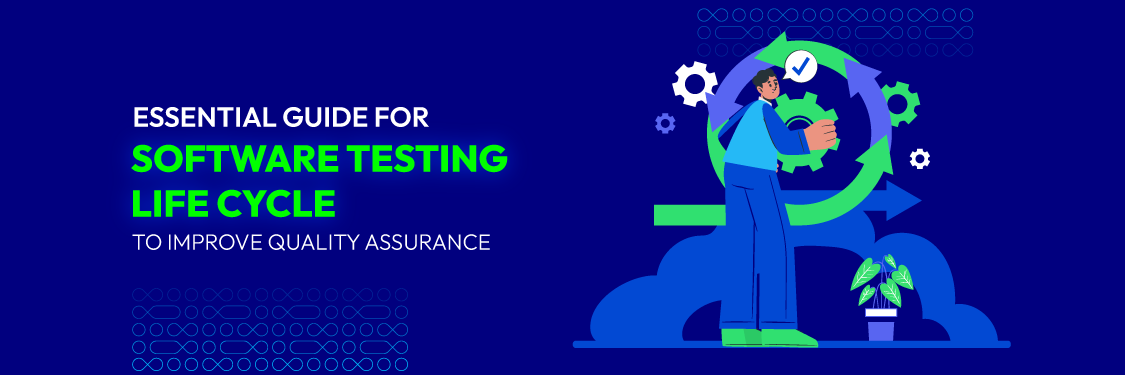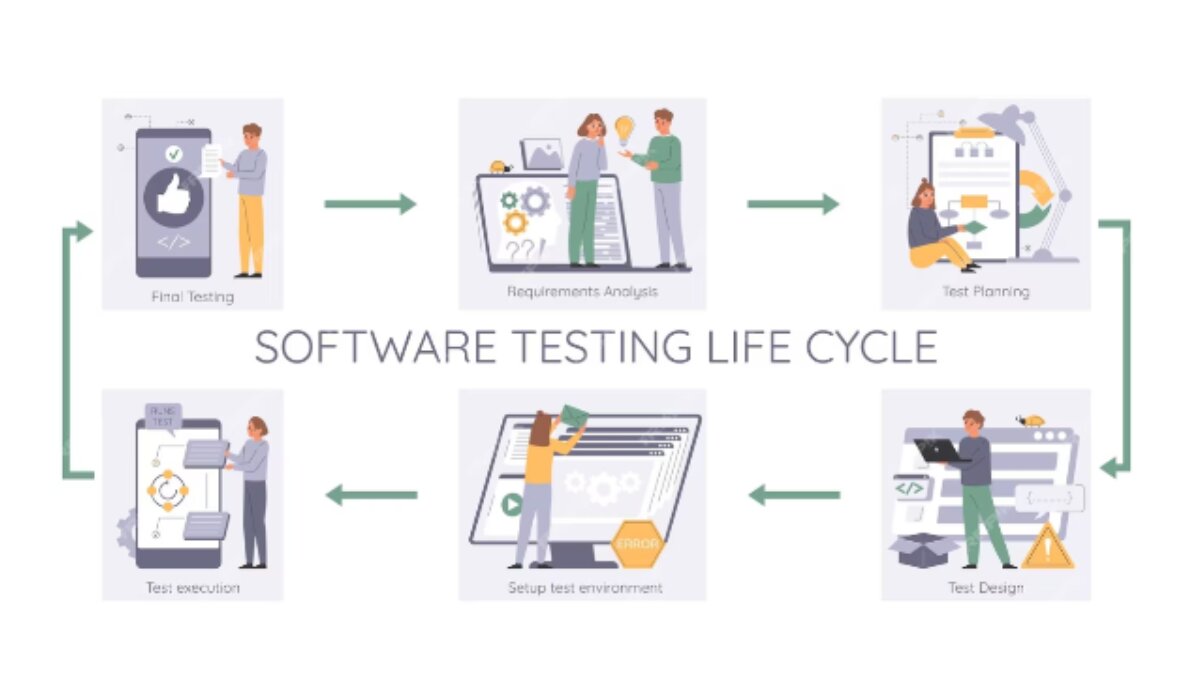Guide for Software Testing Life Cycle to Improve Quality Assurance
Summer Nguyen | 05-08-2024

Learning STLC is important for anyone involved in making software better no matter what role you play. So, what is STLC? It is short for Software Testing Life Cycle, an end-to-end software testing method. Let’s take a closer look and learn how to use that method!
Understanding Software Testing Life Cycle (STLC)
Before knowing how to master STDL, you need to know about it.
Software Testing Life Cycle (STLC) is also known as a plan for checking software. Users can use it to check if the software works well and is good for release.

When using STLC, it’s like you using a checklist to make sure your project goes ok. In simple words, STLC is a way to ensure software is good and works fine before giving it to people.
Role of STLC
Why do people choose to use STLC in testing their products? It can help users primarily discover problems in the software ASAP. Developers can solve them according to records of those issues. Here’s some assistance:
- Increasing effectiveness and consistency, which can help refine testing process
- Estimating the finish of project
- Recoding and following consistently the goals and objectives of projects
- Ensuring that every target can be met
- Testing each feature before passing for adding more.
- Automating analysis process to improve testing quality
So that’s the reason why testing process is faster. Developers can uncover and address issues faster because of clear goals and objectives.

STLC vs SDLC
The main goal of SDLC is to deploy high-quality products. To achieve that, STLC was born as a part of SDLC but only in the testing phases. It plays a very important role in identifying issues and informing developers of updates.
Both STLC and SDLC are closely related in software development but the goals. STLC has completed the testing phase of the SDLC lifecycle. You can use STLC either within SDLC or alongside it.
The main difference between STLC and SDLC is their function. While SDLC handles the entire process of product development, STLC supports SDLC in developing and testing to validate the user requirements.
Key Phases in the Software Testing Life Cycle
STLC has several phases that support testing process from start to finish, including:
Requirement Analysis
Requirement Analysis is the first step in the STLC process. The quality assurance team will review and analyze the requirements to know what needs to be tested. If any requirements require explanation or addition, the quality assurance team consults with stakeholders to ensure a full understanding.
Entry Criteria
- Access to clear and detailed project requirements documentation.
- Understanding stakeholder expectations and company goals.
- Subject matter experts are available to help clarify requirements as needed.
Key activities
- Reviewing Documentation: The quality assurance team thoroughly reviews the Software Requirements Document (SRD) and other associated materials to understand the scope of testing.
- Stakeholder interviews are conducted to acquire further information and resolve any misunderstandings or discrepancies in the requirements.
- Identifying Issues: The team records any ambiguities, inconsistencies, or missing/incomplete requirements for future clarification.
- Risk assessment: Potential dangers or difficulties are documented to ensure that they are effectively addressed.
- Creating Requirement Traceability Matrix (RTM) to map requirements to test cases and ensure thorough test coverage.
Exit Criteria
- Requirements analyzed, prioritized and documented.
- Tracking matrix established.
- Stakeholder-approved requirements for further steps.
Requirement Analysis can ensure a comprehensive grasp of the requirements and detect any difficulties early on. This helps to focus the testing process on the most important aspects of the product, resulting in high-quality findings.
Test Planning
Test planning requires developing a complete test plan outlining the testing strategy, objectives, scope, resources, and schedule. It acts as a road map for all testing operations throughout the STLC.

Entry Criteria:
- Availability of project requirements and specifications.
- Clear understanding of project scope and objectives.
- Defined roles and responsibilities of testing team members.
Key activities:
- Understand Testing Objectives: About functional testing, performance, security…
- Defining Test Scope: About which features will and will not be tested.
- Identifying Test Risks: The potential risks and obstacles connected with testing are identified, and mitigation methods are developed.
- Resource Allocation: Identifying and assigning suitable testing resources to ensure efficiency.
- Developing a Test Plan: Preparing a detailed test plan document about testing methods, scenarios, test cases…
- Review and approval: People who join the project must comment on and approve the test plan.
Exit Criteria
- Comprehensive test plan documented.
- Test strategy and objectives defined.
- Risks identified with mitigation strategies in place.
In conclusion, Test Planning provides a structured approach to testing, aids in the early detection of potential issues, and ensures efficient resource utilization. A well-defined test plan also helps to manage stakeholder expectations and ensure that testing activities are consistent with project objectives and requirements.
Test Case Development
Test Case Development involves creating detailed test cases based on the requirements and test plan. Test cases outline the steps to be followed to verify specific functionalities or scenarios of the software.

Entry Criteria:
- Clear understanding of project requirements and specifications.
- Completed test planning phase.
- Availability of test environment and necessary resources.
Key activities
- Understanding Requirements: Reviewing the software requirements to know what needs to be tested.
- Identifying Test Scenarios: Based on different functional and non-functional aspects, such as user interactions, data validation, error handling…
- Designing Test Cases: Test cases must cover various test scenarios, including steps, outcomes, and preconditions.
- Automated Testing: Using scripting languages or tools to automate the perform of test cases.
- Reviewing and Validation: Ensuring accuracy, completeness, and adherence to testing objectives and requirements.
- Documentation: All test cases must be recorded in a test case repository for future reference.
Exit Criteria
- Test cases developed for all identified scenarios.
- Test cases reviewed and validated for accuracy.
- Test case documentation organized and ready for execution.
Test Case Development is a very important step to find issues and ensure a complete product. Well-designed test cases can improve product quality and validate function, which builds confidence in the product’s dependability and performance.
Test Environment Setup
Test Environment Setup includes setting and preparing the testing environment to as closely resemble the production environment as possible. This includes setting up gear, software, networks, and test data to ensure accurate and efficient testing.
Entry Criteria:
- Availability of hardware and software resources.
- Completed test planning phase.
- Defined requirements for the test environment.
Key Activities:
- Identifying Testing Requirements: Include the hardware, software, and network requirements needed to execute test cases effectively.
- Setting up Hardware and Software: All the tools needed for testing must be installed and configured.
- Network Configuration: Setting network for simulating the production environment accurately.
- Test Data Preparation: Preparing to simulate real scenarios and ensure comprehensive test coverage.
- Integration with Test Management Tools: To streamline testing processes and improve collaboration among team members.
- Environment Validation: Ensure that it accurately reflects the production environment and meets the testing requirements.
Exit Criteria:
- Test environment configured and ready for use.
- Test data prepared and available for testing.
- Sanity checks completed successfully without any critical issues.
Test Environment Setup is an important step for ensuring accurate and effective tests. A properly setup test environment aids in the early detection of flaws or issues in the development process, ensuring that software satisfies quality requirements and user expectations.
Test Execution
Test Execution involves running the identified test cases in the configured test environment to verify whether the software behaves as expected and meets the specified requirements. It is the phase where actual testing activities take place.
Entry Criteria:
- Completed test planning and test case development phases.
- Test environment set up and ready for use.
- Test data prepared and available for testing.

Key Activities:
- Test Case Prioritization: Based on criticality, complexity, and business impact to ensure what are high-priority tests.
- Test Case Execution: The test team executes the provided test cases in the testing environment. Testers will perform the processes indicated in the test cases and document the actual findings.
- Issue Logging: Each issue is recorded with detailed information, including steps to reproduce, severity and priority.
- Regression Testing: To ensure recent changes or fixes do not cause new issues or affect existing functions.
- Ad-hoc Testing: Exploring parts of product that are not covered by defined test cases or specific scenarios.
- Monitoring and Reporting: Any issues identified during this step will be recorded and reported to stakeholders.
Exit Criteria:
- All planned test cases executed as per the test plan.
- Test results recorded and documented.
- Defects reported and tracked in the defect tracking system.
- Regression testing completed successfully without any critical regressions.
This step helps validate the functions, performance, and reliability of the product. Users can identify issues early in the development process. So that, you can ensure that software meets quality standards and user expectations.
Test Closure
Test Closure is the last step of the STLC process. It reviews the testing process against predefined exit criteria, and records testing results, which help users prepare for the next phase of SDLC.

Entry Criteria:
- Completion of test execution phase.
- Resolution of critical defects and completion of regression testing.
- Approval from stakeholders to conclude testing.
Key Activities:
- Test Completion Review: Make sure all planned tests have been executed and all test objectives have been achieved.
- Evaluation Against Exit Criteria: To determine whether the testing objectives have been met, including test coverage, defect closure rate, and adherence to schedule and budget constraints.
- Defect Retesting: Make sure that issues in the testing process have been resolved.
- Test Closure Report: About outcomes, numbers of issues, test coverage, recommendations…
- Handover to Stakeholders: To have the review and approval of stakeholders before running the product.
- Archiving Test Artifacts: Archived documents for future reference and audit purposes.
Exit Criteria:
- Test Summary Report finalized and distributed to stakeholders.
- Lessons learned documented and shared with the team.
- Test closure activities completed, and stakeholders notified.
- Handover to maintenance team, if applicable, successfully executed.
Test Closure is essential for formally ending the testing period and confirming that all test objectives have been met. It gives stakeholders significant insights into the testing process and results, allowing them to make more informed decisions and improve continuously.
The Entry and Exit Criteria in STLC
STLC must meet the Entry and Exit Criteria to be successful. Ideally, the QA team handles this step and only begins/completes the next STLC phase once both criteria are met. Both of these requirements are established for each phase of STLC.
Entry criteria for an STLC phase include completing all precondition conditions that must be completed before testing begins. To begin building test cases, you must have the user requirements document, a thorough understanding of the application flow, and the test plan document. This is the entrance requirement for creating and running test cases.
Exit criteria are all of the information/items that must be available and completed before the end of a phase. It covers all of the actions, tasks, documentation, and test aspects that must be completed before the phase can be marked as complete and moved on to the next.
Best Practices for Software Testing Life Cycle
Following best practices in the STLC provides efficient and effective testing processes. Here’re some best practices:
Collaboration & Communication
Encourage collaboration and communication among teams throughout the STLC:
- Active some channels for team communication such as meetings, tools like Slack or Microsoft Teams…
- Encourage members to share updates, challenges, ideas… in working progress.
- Promote collaboration among meetings, workshops,…
- Using tools, platforms for docs sharing, real-time communication to streamline collaboration.
Automation
Embrace automation where appropriate to increase testing efficiency and coverage:
- Identify repetitive and time-consuming testing procedures that might be automated, such as regression testing, smoke testing, and performance testing.
- Assess and choose appropriate test automation tools based on project specifications, technological stack, and team knowledge.
- Invest in strong and stable test automation frameworks that can be scaled and reused.
- Collaborate with development teams to integrate automated testing into the continuous integration and delivery (CI/CD) pipeline, which will result in quicker feedback and speed to market.
Conclusion
By following to the best practices provided in this book, software quality assurance professionals may successfully navigate each phase of the STLC, optimize testing methods, and improve communication among team members and stakeholders.
Finally, mastering the STLC allows software quality assurance teams to decrease risks, identify problems early in the development process, and ensure that software products meet user expectations, regulatory requirements, and corporate goals.
Organizations that understand the STLC and are committed to excellence may improve their efficiency, productivity, and success in providing high-quality software solutions.




